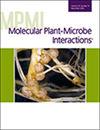求助PDF
{"title":"Thermal Adaptation in Worldwide Collections of a Major Fungal Pathogen.","authors":"Silvia Miñana-Posada, Cécile Lorrain, Bruce A McDonald, Alice Feurtey","doi":"10.1094/MPMI-09-24-0112-FI","DOIUrl":null,"url":null,"abstract":"<p><p>Adaptation to new climates poses a significant challenge for plant pathogens during range expansion, highlighting the importance of understanding their response to climate to accurately forecast future disease outbreaks. The wheat pathogen <i>Zymoseptoria tritici</i> is ubiquitous across most wheat production regions distributed across diverse climate zones. We explored the genetic architecture of thermal adaptation using a global collection of 411 <i>Z. tritici</i> strains that were phenotyped across a wide range of temperatures and then included in a genome-wide association study. Our analyses provided evidence for local thermal adaptation in <i>Z. tritici</i> populations worldwide, with a significant positive correlation between bioclimatic variables and optimal growth temperatures. We also found a high variability in thermal performance among <i>Z. tritici</i> strains from the same field populations, reflecting the high evolutionary potential of this pathogen at the field scale. We identified 69 genes putatively involved in thermal adaptation, including one high-confidence candidate potentially involved in cold adaptation. These results highlight the complex polygenic nature of thermal adaptation in <i>Z. tritici</i> and suggest that this pathogen is likely to adapt well when confronted with climate change. [Formula: see text] Copyright © 2025 The Author(s). This is an open access article distributed under the CC BY-NC-ND 4.0 International license.</p>","PeriodicalId":19009,"journal":{"name":"Molecular Plant-microbe Interactions","volume":" ","pages":"252-264"},"PeriodicalIF":3.4000,"publicationDate":"2025-03-01","publicationTypes":"Journal Article","fieldsOfStudy":null,"isOpenAccess":false,"openAccessPdf":"","citationCount":"0","resultStr":null,"platform":"Semanticscholar","paperid":null,"PeriodicalName":"Molecular Plant-microbe Interactions","FirstCategoryId":"99","ListUrlMain":"https://doi.org/10.1094/MPMI-09-24-0112-FI","RegionNum":3,"RegionCategory":"生物学","ArticlePicture":[],"TitleCN":null,"AbstractTextCN":null,"PMCID":null,"EPubDate":"2025/3/28 0:00:00","PubModel":"Epub","JCR":"Q2","JCRName":"BIOCHEMISTRY & MOLECULAR BIOLOGY","Score":null,"Total":0}
引用次数: 0
引用
批量引用
Abstract
Adaptation to new climates poses a significant challenge for plant pathogens during range expansion, highlighting the importance of understanding their response to climate to accurately forecast future disease outbreaks. The wheat pathogen Zymoseptoria tritici is ubiquitous across most wheat production regions distributed across diverse climate zones. We explored the genetic architecture of thermal adaptation using a global collection of 411 Z. tritici strains that were phenotyped across a wide range of temperatures and then included in a genome-wide association study. Our analyses provided evidence for local thermal adaptation in Z. tritici populations worldwide, with a significant positive correlation between bioclimatic variables and optimal growth temperatures. We also found a high variability in thermal performance among Z. tritici strains from the same field populations, reflecting the high evolutionary potential of this pathogen at the field scale. We identified 69 genes putatively involved in thermal adaptation, including one high-confidence candidate potentially involved in cold adaptation. These results highlight the complex polygenic nature of thermal adaptation in Z. tritici and suggest that this pathogen is likely to adapt well when confronted with climate change. [Formula: see text] Copyright © 2025 The Author(s). This is an open access article distributed under the CC BY-NC-ND 4.0 International license.
一种主要真菌病原体在世界范围内的热适应性。
适应新气候对植物病原体在范围扩大过程中提出了重大挑战,这突出了了解它们对气候的反应对于准确预测未来疾病爆发的重要性。小麦致病菌小麦酵母菌普遍存在于分布在不同气候带的大多数小麦产区。我们利用全球收集的411株小麦黑麦草菌株(Z. tritici)来探索热适应的遗传结构,这些菌株在广泛的温度范围内进行表型分析,然后将其纳入全基因组关联研究。研究结果表明,小麦黑麦种群存在局部热适应,生物气候变量与最佳生长温度呈正相关。我们还发现,来自同一田间群体的麦兹菌菌株在热性能方面存在很大的差异,这反映了该病原体在田间规模上的高进化潜力。我们确定了69个与热适应有关的基因,包括一个高可信度的候选基因,可能与冷适应有关。这些结果凸显了小麦偃麦草热适应的复杂多基因特性,表明该病原菌在面对气候变化时可能具有良好的适应能力。
本文章由计算机程序翻译,如有差异,请以英文原文为准。

 求助内容:
求助内容: 应助结果提醒方式:
应助结果提醒方式:


